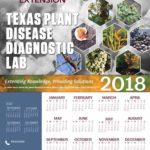 Leafy or True Mistletoe
Leafy or True Mistletoe
SCIENTIFIC NAME of causal agent: Phoradendron tomentosum
DISEASE DESCRIPTION
Mistletoe are commonly found on many hardwoods such as oaks, pecans, elms, and hackberries.
SYMPTOMS: The characteristic sign of mistletoe infection is the presence of the evergreen plant growing on the branch of a tree. The flowering mistletoe plants have small round leaves, thick green stems, and pearly white berries. Most mistletoe plants reach a maximum size of 12 – 18 in. diameter. At the point of attachment of the mistletoe plant to the branch, there will often be a swollen area on the branch. Rarely, the branch will die back at the swollen area, usually during periods of stress such as extreme drought. Most trees do not exhibit any other symptoms of infection.

BIOLOGY: Leafy mistletoes are not complete parasites because they only withdraw water from their tree hosts. They are spread when birds eat the sticky berries and deposit the seeds in their droppings as they perch on other branches and trees. The berries may also stick to their legs or beaks and be wiped off on different branches. The seed then germinates and penetrates the bark of the tree to initiate the new infection. For 2 – 3 years, a specialized root system grows in the branch, followed by emergence of a new mistletoe plant. The evergreen nature of mistletoe led ancient cultures to believe it had magical powers and made it the focus of traditional lore.

MANAGEMENT METHODS: The most effective control for leafy mistletoe is to prune the branch on which the plant is growing. The pruning cut should be made at least 12 in. below the point of attachment to be certain the internal root structure of the plant is removed completely. Simply cutting the plant from the branch will lead to rapid and vigorous proliferation of a new plant at the same spot. A growth regulator, ethephon, may be used to temporarily kill the shoots of the mistletoe plant, but the effect is temporary and the same location will need to be retreated within a few years. A thorough, community-wide effort is needed to effectively reduce mistletoe infections in a neighborhood or similar population of trees.
RESOURCE LINKS:
http://ipm.ucanr.edu/PMG/PESTNOTES/pn7437.html
Authored by Dr. David Appel, Professor & Extension Specialist
